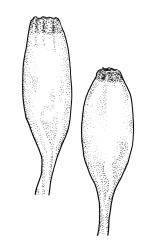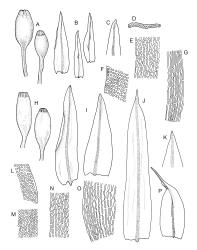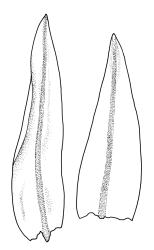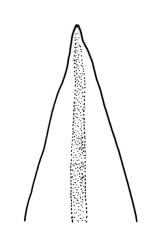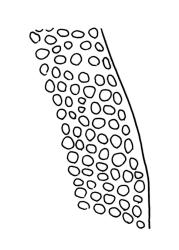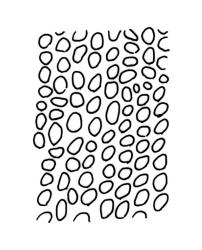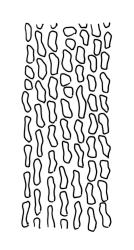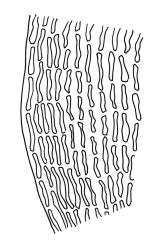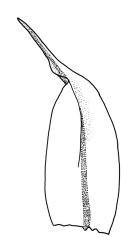Plants robust, light green to olive-green above, dark green below, on bark. Branches to 30 mm, ascendant, simple or forked below terminal perichaetia. Stem leaves ovate-lingulate to ovate, abruptly narrowed to long-acuminate and reflexed apices, widely spreading to squarrose-recurved from sheathing bases when moist, c. 1.0–1.5 mm. Branch leaves loosely erect-appressed, slightly curved to one side and weakly funiculate when dry, erect or slightly recurved when moist, ovate- to oblong-lanceolate, broadly or sometimes narrowly acute, strongly keeled, 2.0–3.0(–3.3) mm; margins entire, plane; upper laminal cells irregularly rounded-quadrate, but a few rounded-elliptic or elliptic-oblate, mostly 5–8 × 5–8 μm, smooth, unistratose; mid laminal cells longer and more rectangular than upper cells, somewhat irregular, mostly 9–12(–15) × 3–7 μm; inner basal cells elongate-rectangular, very thick-walled, smooth, often ± sigmoid near mid leaf, 20–90 × 8–10 μm (lumina c. 2–3 μm wide), shorter near the costa; marginal basal cells less irregular, often longer and narrower than adjacent cells. Costa percurrent to very short-excurrent, the abaxial superficial cells elongate in lower portion but rounded-quadrate above, in cross-section 3–5 layered, with stereids and guide cells not well differentiated. Gemmae absent.
Pseudautoicous. Perichaetial leaves differentiated, larger than vegetative, oblong to oblong-lanceolate, acuminate to acuminate-cuspidate, sheathing the lower setae, mostly 3.3–4.5 mm. Male plants dwarf, gemmiform, mostly less than 1 mm, the inner bracts ovate-acute, with few antheridia and apparently lacking paraphyses. Setae 6–13 mm, smooth, flexuose, sinistrorse; capsules oblong-elliptic to fusiform, smooth below, puckered, 8-plicate, and darker at mouth, mostly c. 2.0–3.0 mm; exothecial cells thick-walled, variably rectangular to elliptic, mostly 20–60 μm long, becoming shorter and coloured near mouth; stomata, annulus, and operculum as per genus. Peristome single; exostome teeth 16, a few partially fused, blunt, pale, irregularly papillose, inserted below rim. Calyptra deeply 2–3 lacerate, with several shallow slits and often one elongate slit, campanulate or ± cucullate, smooth, strongly plicate. Spores indistinctly anisosporous, papillose, 16–42 μm.
Vitt 1983, figs 83–35, 87–96; Brotherus 1925, fig. 448.
This large, robust, and exceedingly attractive species is distinguished from other N.Z. members of the genus by its yellow- to olive-green coloration, and its weakly curved and non-funiculate leaves when dry. Numerous other features also serve to distinguish M. orthophyllum. These include smooth, rather small upper leaf cells, smooth basal cells, enlarged perichaetial leaves that sheathe the lower setae, long and sinistrorse setae, mostly oblong-elliptic capsules that are abruptly darkened, puckered, and 8-plicate at the mouth, weakly anisosporous spores, and pseudautoicous sexual condition. The dwarf male plants can often be easily seen in this species.
Among Macromitrium species with smooth, flat upper laminal cells, only the much commoner M. longipes approaches M. orthophyllum in size. However, M. orthophyllum differs from M. longipes by its olive-green coloration; its branch leaves, which are only slightly curved and weakly funiculate when dry; its decidedly less sigmoid basal laminal cells; its somewhat anisosporous spores; and its dwarf male plants.
NI: S Auckland (near Tauranga, near Tīrau), Gisborne (Lake Waikaremoana), Hawke’s Bay (Wakarara Range, near Eskdale, Ruahine Range), Wellington (Puketoi Range, near Martinborough); SI: Nelson (near Upper Tākaka, near Nelson), Marlborough (Resolution Bay, Mt Fyffe, Blue Duck Scientific Reserve), Canterbury (including Banks Peninsula), Otago, Southland (Lake Hauroko). Most South I. collections are from Canterbury and Otago L.D. This species is not documented from west of the Main Divide on the South I. or from western or northern regions on the North I.
Endemic
Macromitrium orthophyllum is an infrequently collected epiphytic species and many herbarium records of it lack host information. Vitt’s (1983, p. 37) suggestion that it does not occur in association with southern beech forest needs qualification, since it occurs on Fuscospora solandri s.l. at Lake Hauroko, Southland L.D. (A.J. Fife 13149, CHR 617384) and Mt Thomas, Canterbury L.D. (D. Glenny, s.n., CHR 438727) as well as an unspecified southern beech species at Maungatua, Otago L.D. (W. Martin 298.2, CHR 547681). Vitt's statements that this species has a predominantly eastern distribution and that it is most frequent from podocarp-broad-leaved forests hold true. It is recorded from the trunks of the podocarps Dacrycarpus dacrydioides, Dacrydium cupressinum, Prumnopitys ferruginea, and P. taxifolia, as well as Fuscospora solandri s.l., Griselinia littoralis, Weinmannia racemosa, and Cordyline australis. It is restricted to lower elevations than most of its congeners, ranging from near sea level (Resolution Bay) to only c. 500 m (Mt Fyffe). No other Macromitrium species has such a predominantly eastern distribution in N.Z. Associated bryophytes include Dicnemon calycinum, Leptostomum inclinans, Lepyrodon australis, Macromitrium grossirete, Orthorrhynchium elegans, Rhaphidorrhynchium amoenum, Weymouthia mollis, and the lichen genus Leptogium.
Macromitrium orthophyllum is allied to M. longipes, and is placed with it and M. microstomum in a group of seven related Australasian species by Vitt & Ramsay (1985).



